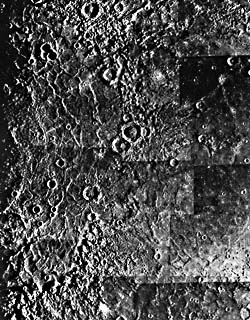 |
|---|
| Plate P-3 |
 |
|---|
| Plate P-3 |
The planet Mercury was physiographically terra incognita before 1974, when Mariner 10 telemetered to Earth the first high-resolution photos of its surface (Murray et al., 1981). The instinctive reaction of those of us who saw those pictures as they were received was: "It´s just like the Moon!" Perhaps the most striking analogy between lunar and Mercurian physiography was not evident until several pictures were mosaicked to show the Caloris Basin (Plate P-4), which appears to be a near-twin in size and topography to the Orientale Basin on the Moon (Figure P-4.1). This analogy will be illustrated with a view of the ejecta blanket from the Imbrium Basin (Figure P-4.2) and two close-up views of the Orientale Basin (Figures P-4.3 and P-4.4).
Turning first to the Texas-sized Caloris Basin, note that this collective term embraces several discrete terrain features. The heavily ridged area on the left, occupying roughly one-third of the picture, has been named Caloris Planitia (plains), and the arcuate mountains enclosing it, the Caloris Montes (mountains). The Caloris Planitia should be compared first with a previous view (Plate P-3) of Mare Tranquillitatis. It is obvious that the ridges criss-crossing Caloris Planitia are at least grossly similar to the mare ridges, raising the obvious question of whether the Mercurian plains are in fact maria and presumably lava flows.
| Figure P-4.1 | Figure P-4.2 |
|---|---|
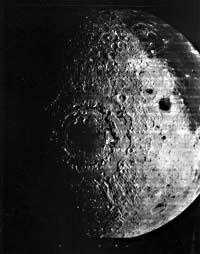 |
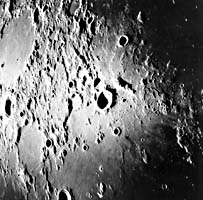 |
The majority opinion is that they are and that Mercury has undergone a period of extensive basaltic volcanism analogous to that of the Moon (Strom, 1984). The Mercurian planitia are generally lower, smoother, and much less cratered than the Mercurian highlands (shown in Plate P-5), although there is no strong albedo contrast as displayed by the Moon. Reflection spectra of Mercury (Hapke, 1977) reveal features characteristic of pyroxenes, suggesting at least some compositional similarity in that pyroxenes are a major component of lunar basalts. Add to this the fact that similar ridges on the Moon are almost invariably found in mare terrain, then the evidence collectively strongly favors the interpretation that the Mercurian plains are lava flows. However, the possibility remains that they are some sort of impact ejecta analogous to the Cayley Formation of the Moon, and the nongenetic term "planitia" rather than "maria" is thus an appropriate one.
The Orientale Basin (Figure P-4.1) has long been recognized as a younger and better-preserved version of the Imbrium Basin and, by implication, is therefore an immense impact crater. Its physiography is relevant to possibly analogous features associated with the Caloris Basin. Look first at an Apollo east-looking view of the ejecta blanket south of Mare Imbrium (Figure P-4.2). This terrain, near the type locality of the Fra Mauro formation, shows the radiating hills and valleys typical of most of the mountains surrounding the Imbrium Basin. It should be compared with the hills radiating from the Caloris Basin (Plate P-4). Although not as well preserved or displayed as the lunar terrain, Mercurian features fall clearly into the same general type of physiography and represent, by implication, the ejecta blanket from the Caloris Basin. However, there is an important difference between the Caloris and Orientale Basins, although this difference is not completely shown by the Mariner picture. Ejecta from the Orientale Basin (the Helvelius Formation) can be recognized in some directions several hundred kilometers from it (i.e., at least one basin diameter away). The ejecta from the Caloris Basin has apparently traveled much less distance. The obvious explanation for this is that, although Mercury and the Moon are superficially very similar, Mercury has a surface gravitational acceleration more than twice that of the Moon because of its much greater mass. Ejecta from Mercurian craters will therefore travel much less distance, other factors being equal, than on the Moon.
| Figure P-4.3 | Figure P-4.4 |
|---|---|
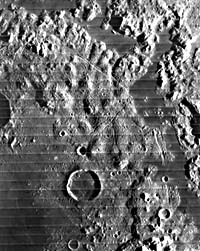 |
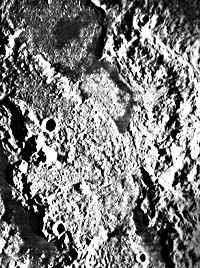 |
Although they are not strikingly similar to those of the Caloris Basin, the inner parts of the Orientale Basin are worth discussing briefly. The central part of the Orientale Basin is partly filled with mare material. Surrounding this area (Mare Orientale) is a broad ring of subdued hills, the Rook Mountains (Figure P-4.3). These hills are clearly younger than the adjacent mare area and have been mapped by USGS geologists as the Maunder Formation, interpreted as being chiefly impact melt, with occasional hills of prebasin bedrock projecting through it. Outward from the Maunder Formation (Figure P-4.4) is another concentric ring of material, which has been interpreted not as impact melt but as the inner facies of the ejecta blanket, which should correspond to some part of the terrain inside the Caloris Montes. Whether it does is left to the reader´s judgement; however, it should be remembered that we are not seeing a complete cross section of the Caloris Basin and may be missing critical parts of it.
The Caloris Basin (left side of Plate P-4) differs from the Orientale Basin in that it contains polygonal blocks; there is nothing like this terrain on the Moon. However, comparable fracturing exists on Mars, with blocks of similar size. Their origin is unknown, although simple shrinkage (analogous to mud cracks) seems unlikely because of their size. Some sort of tectonic tension fracturing seems more likely; possibly, a similar explanation could apply to Mercury.
The discussion of the Caloris Basin has concentrated on similarities between Mercury and the Moon, but it is stressed that Mercury is internally quite different. Its high density (greater than that of the Earth if allowance is made for compression) clearly indicates a large iron core-unlike the Moon. Bruce Murray has characterized Mercury as "like the Moon on the outside, and like the Earth on the inside" (Murray et al., 1981). 74-H-536.
Continue to Plate P-5| Chapter 10 Table of Contents.| Return to Home Page| Complete Table of Contents|